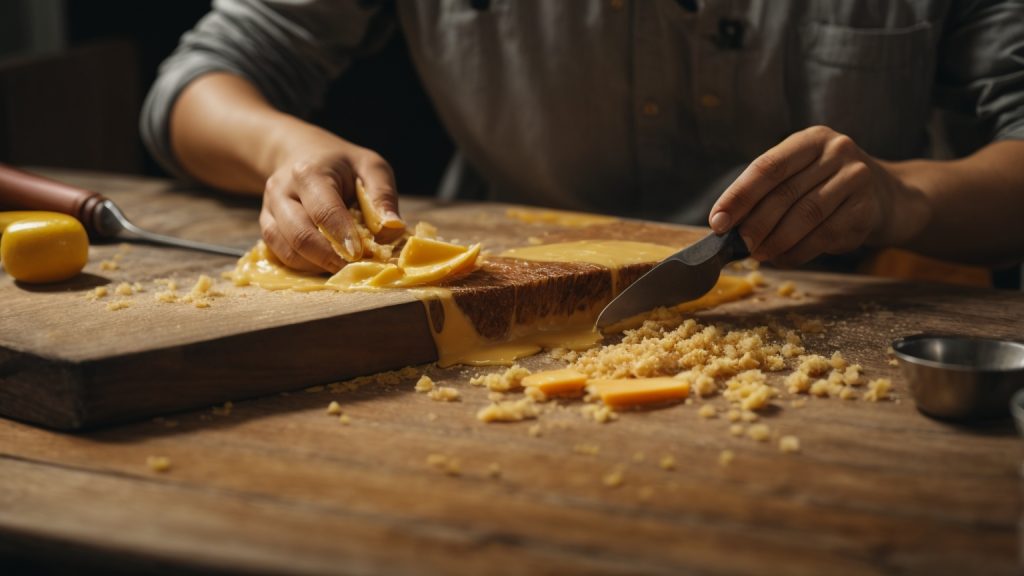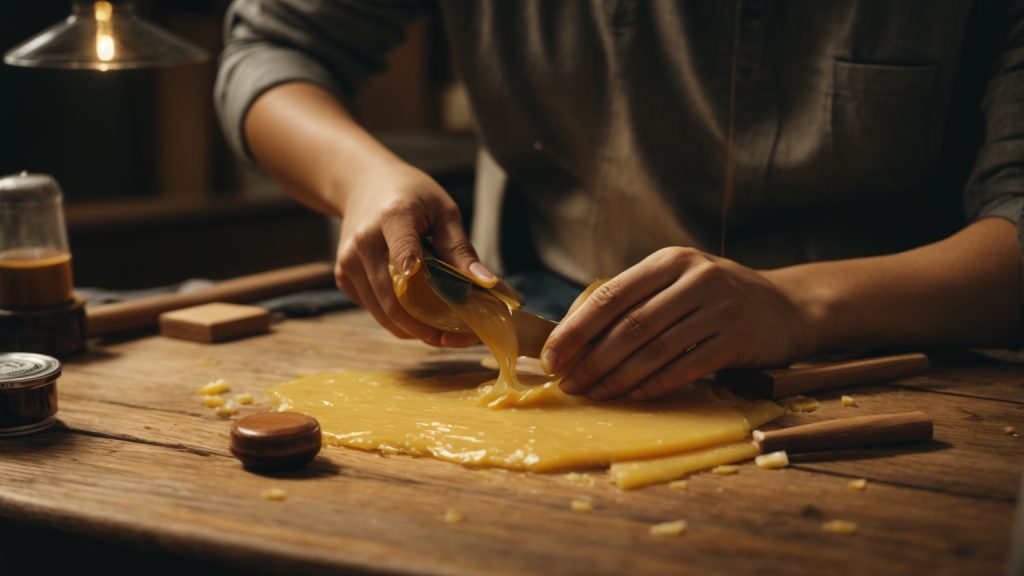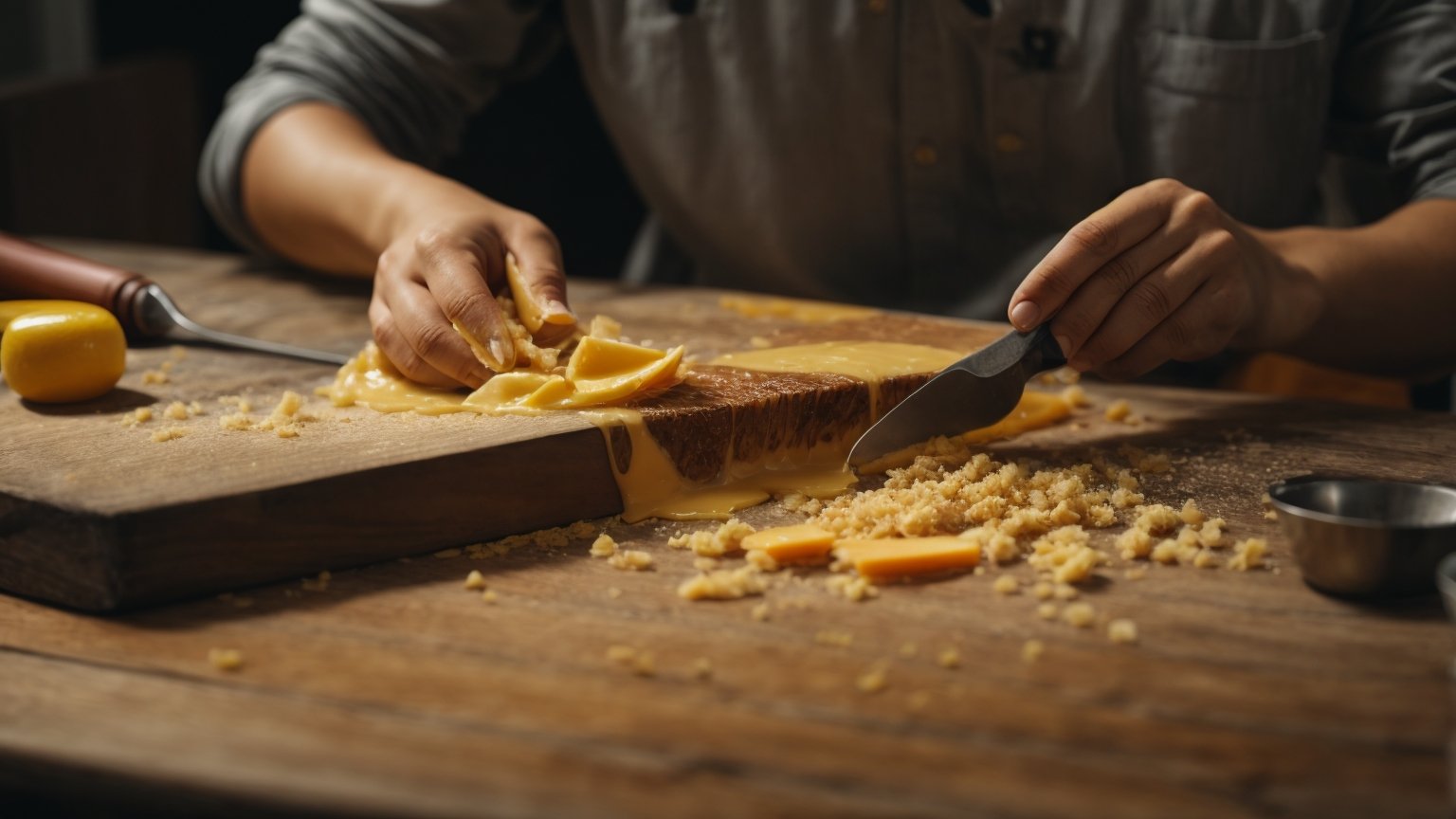If you have a wooden table that is covered in wax, you may be wondering how to remove it. Wax can build up over time, leaving your table looking dull and dirty. Fortunately, there are several methods you can use to remove wax from a wooden table.
One of the easiest ways to remove wax from a wooden table is with distilled vinegar and water. Mix equal parts of vinegar and water in a bowl, and then use a cloth to apply the solution to the table. Let the solution sit for a few minutes, and then wipe the table clean with a dry cloth.
Another method for removing wax from a wooden table is to use heat. Place a clean cloth over the wax, and then use a warm iron to heat the cloth. The heat will melt the wax, allowing it to be absorbed by the cloth. Repeat this process until all of the wax has been removed from the table.
Understanding Wax and Wood

If you have a wooden table that has been waxed, you may notice that over time, the wax can build up and leave a residue that can be difficult to remove. Before attempting to remove the wax, it’s important to understand a bit about how wax and wood interact.
How Wax Protects Wood
Wax is a natural substance that has been used for centuries to protect and beautify wood. When applied to wood, wax creates a protective layer that helps to repel water and other liquids. This can help to prevent stains and damage from spills.
Wax also helps to enhance the natural beauty of wood by bringing out its natural grain and color. This can give wood a warm, inviting glow that is difficult to achieve with other finishes.
Why Wax Buildup Occurs
While wax is a great way to protect and beautify wood, it can also cause problems if it is not properly maintained. Over time, wax can build up on the surface of wood, creating a hazy, cloudy appearance. This can make the wood look dull and unattractive.
Wax buildup can occur for a number of reasons, including:
- Over-application of wax
- Failure to properly buff the wax after application
- Using the wrong type of wax for the wood
- Failure to properly clean the wood before applying wax
How to Remove Wax from Wood
If you have a wooden table with wax buildup, there are several methods you can use to remove the wax. Some of the most effective methods include using heat, solvents, or a combination of both.
Before attempting to remove the wax, it’s important to test any method you plan to use on a small, inconspicuous area of the table to ensure that it does not damage the wood. Once you have determined that the method is safe to use, you can then proceed with removing the wax from the rest of the table.
By understanding how wax and wood interact, you can take steps to prevent wax buildup and keep your wooden table looking beautiful for years to come.
Precautions Before Starting
Before you start removing wax from your wooden table, there are a few precautions you should take to ensure that you don’t damage the wood or harm yourself. Here are some things to keep in mind:
Protect Your Hands
Wax removal typically involves using solvents or other chemicals that can be harmful to your skin. To protect your hands, wear gloves while working with these substances. Latex gloves are a good option, but if you have sensitive skin, you may want to opt for nitrile gloves instead.
Test the Solvent
Before you start removing wax from your table, test the solvent you plan to use on a small, inconspicuous area of the wood. This will help you determine whether the solvent will damage the finish or discolor the wood. Apply a small amount of the solvent to the test area and wait a few minutes to see if any damage occurs.
Work in a Well-Ventilated Area
Many wax removal solvents produce fumes that can be harmful if inhaled. To protect your health, work in a well-ventilated area. Open windows and doors to allow fresh air to circulate, and consider wearing a respirator mask if you’re working with particularly strong solvents.
Protect Your Work Surface
When removing wax from your table, you’ll likely be using solvents or other substances that can damage the surface of your work area. To protect your table or countertop, cover it with a drop cloth or plastic sheeting before you begin.
Be Patient
Removing wax from wood can be a time-consuming process, especially if the wax has been on the wood for a long time. Be patient and take your time to ensure that you remove all of the wax without damaging the wood. Rushing the process can lead to mistakes and damage to the wood.
Tools Needed for Wax Removal
Removing wax from a wooden table is not a difficult task, but you will need some tools to do it properly. Here are the tools you will need:
1. Soft Cloth
You will need a soft cloth to wipe the table after removing the wax. Make sure the cloth is clean and dry before using it.
2. Plastic Scraper
A plastic scraper is a useful tool for removing hardened wax from the table surface. It is important to use a plastic scraper to avoid scratching the wood.
3. Hair Dryer or Iron
A hair dryer or iron can be used to soften the wax before scraping it off. Be careful not to overheat the wood, as this can cause damage.
4. Distilled White Vinegar
Distilled white vinegar is a natural cleaning agent that can be used to remove wax residue from the table. Mix equal parts of vinegar and water in a bowl and use a soft cloth to apply the solution to the table.
5. Furniture Polish
After removing the wax, it is a good idea to apply furniture polish to the table to restore its shine. Choose a polish that is suitable for your type of wood and follow the instructions on the label.
Having these tools on hand will make the wax removal process much easier and more effective. With a little bit of patience and elbow grease, you can restore your wooden table to its former glory.
Step-by-Step Guide to Removing Wax
If you have a wooden table that has been covered in wax, don’t worry. Removing wax from a wooden table is a straightforward process that you can do yourself. Here is a step-by-step guide to help you remove wax from your wooden table:
- Scrape off the wax: Using a plastic scraper or credit card, gently scrape off as much of the wax as possible. Be careful not to scratch the surface of the wood.
- Soften the wax: If there is still wax remaining on the table, use a hair dryer or clothing iron on a low setting to soften the wax. Place a clean cloth over the wax and run the hair dryer or iron over the cloth. The heat will melt the wax, and the cloth will absorb it.
- Wipe off the wax: Once the wax has been softened, wipe it off with a clean cloth. Be sure to use a new section of the cloth for each wipe to avoid spreading the wax around.
- Remove any residue: If there is still residue left on the table, mix equal parts white vinegar and water in a spray bottle. Spray the solution onto a microfiber cloth and use it to wipe the surface of the furniture, following the direction of the wood grain. Apply firm but gentle pressure, focusing on areas with heavy wax buildup.
- Polish the table: After removing the wax and residue, polish the table with furniture polish or wax to restore its shine. Apply the polish or wax with a clean cloth, and buff it in with a separate cloth.
By following these simple steps, you can easily remove wax from your wooden table and restore its natural beauty.
Cleaning the Table After Wax Removal

Now that you have successfully removed the wax from your wooden table, it’s time to clean it up and restore its shine. Here are some tips to help you clean your table effectively:
- Use a damp cloth: After removing the wax, use a clean, damp cloth to wipe down the table. Make sure to remove any remaining wax residue and dirt.
- Dry the table: After wiping down the table, use a dry cloth to remove any excess moisture. This will prevent water damage to the wood.
- Apply furniture polish: To restore the shine of your wooden table, apply a furniture polish. Choose a polish that is specifically designed for wooden furniture. Apply the polish in a circular motion and buff it with a clean cloth.
- Avoid harsh chemicals: Avoid using harsh chemicals or abrasive materials that can damage the wood. Instead, opt for gentle cleaning solutions that are safe for wooden surfaces.
- Regular maintenance: To keep your wooden table looking its best, it’s important to maintain it regularly. Wipe it down with a damp cloth every few days and apply furniture polish once a month.
By following these simple tips, you can keep your wooden table looking beautiful for years to come.
Maintaining Your Wooden Table
Your wooden table is a beautiful and functional piece of furniture that can last for years with proper care. One of the most important aspects of maintaining your wooden table is to keep it clean and free of wax buildup. Here are some tips to help you keep your wooden table in top condition:
1. Clean spills immediately
Wood is a porous material and can easily absorb liquids, which can cause stains and damage to the surface. To prevent this, make sure to clean up spills immediately using a clean, damp cloth. Avoid using harsh chemicals or abrasive cleaners that can scratch the surface of the wood.
2. Use coasters and placemats
To protect your wooden table from scratches and stains, use coasters and placemats under glasses, plates, and other objects. This will help prevent water rings, heat marks, and other damage to the surface of the wood.
3. Dust regularly
Dust can accumulate on the surface of your wooden table, which can make it look dull and unattractive. To prevent this, dust your table regularly using a soft, dry cloth or a feather duster. Avoid using a wet cloth or cleaning products that can damage the finish of the wood.
4. Use furniture wax sparingly
While furniture wax can help protect the surface of your wooden table, it can also build up over time and create a dull, sticky residue. To prevent this, use furniture wax sparingly and only when necessary. Apply a thin layer of wax using a soft cloth and buff it gently with a clean, dry cloth.
By following these simple tips, you can keep your wooden table looking beautiful and functional for years to come.
Common Mistakes to Avoid
Removing wax from a wooden table can be a tricky task, and there are some common mistakes that people make that can actually make the problem worse. Here are some things to avoid when removing wax from your wooden table:
Using Hot Water
One common mistake people make when trying to remove wax from a wooden table is using hot water. While hot water may seem like a good idea because it can melt the wax, it can also damage the wood. Hot water can cause the wood to expand and warp, which can lead to permanent damage. Instead, use room temperature water to soften the wax before removing it.
Scrubbing Too Hard
Another mistake people make when removing wax from a wooden table is scrubbing too hard. Scrubbing too hard can scratch the surface of the wood, leaving it looking dull and damaged. Instead, use a soft cloth or sponge to gently remove the wax.
Using Harsh Chemicals
While it may be tempting to use harsh chemicals to remove wax from your wooden table, this can actually do more harm than good. Harsh chemicals can strip the finish off the wood, leaving it looking dull and damaged. Instead, use a mild cleaner that is safe for use on wood.
Not Protecting the Wood
After you have removed the wax from your wooden table, it is important to protect the wood to prevent further damage. One mistake people make is not protecting the wood after cleaning it. Be sure to apply a protective coating to the wood to prevent scratches and damage.
By avoiding these common mistakes, you can safely and effectively remove wax from your wooden table without causing any damage.
Alternative Methods for Stubborn Wax
If the wax on your wooden table is particularly stubborn, there are a few alternative methods you can try to remove it. Here are some options to consider:
Use Mineral Spirits
Mineral spirits are a type of solvent that can be effective at dissolving wax buildup on wooden surfaces. To use this method, follow these steps:
- Apply a small amount of mineral spirits to a clean, soft cloth.
- Rub the cloth over the wax buildup, applying gentle pressure.
- Continue rubbing until the wax is dissolved and removed.
- Wipe the area clean with a separate clean cloth.
It’s important to note that mineral spirits can be flammable, so be sure to use them in a well-ventilated area and away from any sources of heat or flames.
Try a Hair Dryer
Another option for removing stubborn wax is to use a hair dryer. Here’s how to do it:
- Set your hair dryer to its lowest heat setting.
- Hold the hair dryer a few inches away from the wax buildup.
- Move the hair dryer back and forth over the wax, heating it up until it begins to melt.
- Wipe the melted wax away with a clean cloth.
- Repeat as necessary until all the wax is removed.
Be careful not to hold the hair dryer too close to the wood, as this could cause damage.
Use a Plastic Scraper
If the wax on your table is particularly thick, you may need to use a plastic scraper to remove it. Here’s how:
- Use a plastic scraper to gently scrape away as much of the wax as possible.
- Apply a small amount of mineral spirits to a clean, soft cloth.
- Rub the cloth over the remaining wax buildup, applying gentle pressure.
- Continue rubbing until the wax is dissolved and removed.
- Wipe the area clean with a separate clean cloth.
Be careful not to use a metal scraper, as this could scratch or damage the wood.
Sand the Table
If all else fails, you may need to sand your table to remove the wax buildup. Here’s how:
- Use a fine-grit sandpaper to sand the wax buildup off the table.
- Be sure to sand with the grain of the wood to avoid causing any damage.
- Once the wax is removed, wipe the table clean with a damp cloth.
- Allow the table to dry completely before applying any new finish or wax.
Keep in mind that sanding your table should be a last resort, as it can be time-consuming and may damage the wood if not done carefully.
Professional Help for Wax Removal
If you have tried all the DIY methods and still cannot remove the wax from your wooden table, it may be time to call in the professionals. Here are some options to consider:
Furniture Restoration Companies
Many furniture restoration companies specialize in removing wax buildup from wooden furniture. These companies have the expertise and tools necessary to safely remove the wax without damaging your table.
When choosing a furniture restoration company, do your research to ensure that they have experience working with wooden tables and that they use safe and effective methods for wax removal.
Professional Cleaners
Professional cleaners may also be able to remove the wax from your table. Look for cleaners who specialize in wood cleaning and restoration.
When hiring a professional cleaner, make sure that they are experienced and have a good reputation. Ask for references and read reviews online before making a decision.
Furniture Refinishers
If your table has significant damage from the wax buildup, you may need to hire a furniture refinisher to restore it. Refinishers can repair and refinish the table to make it look like new again.
When choosing a furniture refinisher, make sure that they have experience working with wooden tables and that they use safe and effective methods for wax removal and refinishing.
Remember, hiring a professional can be more expensive than DIY methods, but it may be necessary if the wax buildup is severe or if you do not feel comfortable attempting to remove it yourself.
